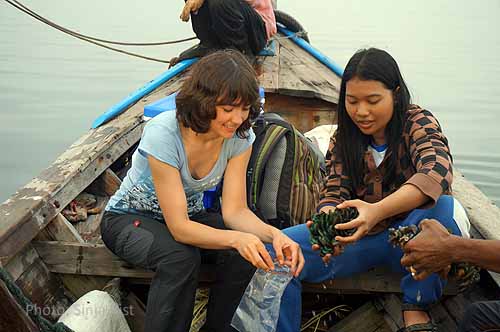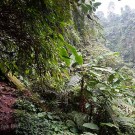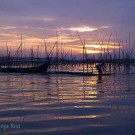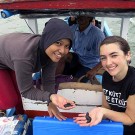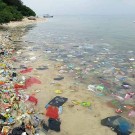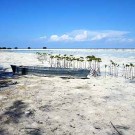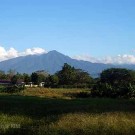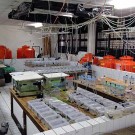by Team Indonesia Khoirunnisa Assidqi & Sinja Rist
The most striking fact about our research station is probably that it is in the centre of Java and therefore not located at the sea. Although it seems that Indonesia, a country with 17.508 islands, consists of almost nothing but water, one of the best universities for marine biology is located inland. Bogor is a 950.000 inhabitants city in the southern outskirts of Jakarta and it takes at least 1.5 hours by car to reach the coast. This makes the work here in many aspects different from the way teams work at the other stations of the GAME research network. For instance, we have to store the seawater for our experiments in big tanks in the lab and recycle it by the use of filter units instead of having a sea water flow-through system. And every kind of fieldwork requires a long trip. But still our work here started very similar to what the other teams experienced: First, we had to equip the laboratory and adjust it to our needs before we could start collecting test animals for pilot studies.
Our filter feeding species was determined very quickly to be Perna viridis, a mussel which was already used for many experiments in our lab. This was very helpful as there is a lot of experience here in how to collect this bivalve and how to treat it. In the Bay of Jakarta fishermen harvest this species from simple bamboo constructions, which are placed in shallow parts of the bay, and sell the mussels at the local market. Every morning they go out in their small boats to collect those mussels big enough for the market and this is exactly how we got our mussels for the lab. Pak Baso is the owner of a small wooden boat and a few dozen bamboo constructions in the bay. He was always smiling under his big bamboo hat and took us with him whenever we showed up at the harbour before sunrise. This means that we needed to leave Bogor at 3:30 am to be there on time and with the first rays of light we glided into the bay. Two or three fishermen were then diving down to collect the mussels and threw them on deck, where we could collect the ones that we needed. Like this it was always very easy for us to get enough mussels for the experiments.
However, it was more difficult to find a suitable deposit feeding species. We decided not to use the same animal as the GAME team last year – a gastropod that lives in mangrove forests- and therefore had to keep our ears and eyes open for alternatives. Sea cucumbers – they are echinoderms which are related to sea stars and sea urchins – were the first idea that we had, but populations of these animals are shrinking in many parts of Indonesia. So, at the beginning it seemed like it would not be possible to find them in sufficient numbers and we looked for other animals that ingest sediment. One trial with a worm species (polychaeta) failed, because they were not fully marine and did not tolerate the seawater in our aquaria system. On a trip to the ‘Thousand Islands’ (a group of really a lot of islands north of Java) we found a few sea cucumbers, but there were not enough for our experiment. After looking and asking around without any results we almost got desperate. We also did not have enough time to check out all of these small islands. But then we luckily got a hint to visit one specific island and we could not believe our eyes when we got there: The shallow water close to the shore was full with sea cucumbers. So we had finally found our deposit feeder! However, to ensure that the population we discovered will not collapse as a consequence of our ‘harvest’, we did not take more than 1% of the animals that were present there.
After successful pilot studies in which we could show that both species, the mussels and the sea cucumbers, ingest the PVC particles we chose for our experiments, we were ready to go for the main experiment… until our water crisis began. To have enough water at hand during the experiment, we ordered new seawater, filled up our tanks and thought that everything was prepared. But suddenly our mussels started to die and after two days in the new water not one single mussel was alive. Luckily, it was not that bad with the sea cucumbers, but still mortality among them was so high that we did not had enough of them left for the experiment. Unfortunately, we were not able to determine what exactly killed our animals, but it was obviously very toxic to them. So, we had to pour all the water away, clean our tanks and filters and – the most time consuming part – collect new animals. That was a very frustrating week, but we did not let that bring us down!
Seeing it from a positive side, this gave us the chance to make some more trips to the ‘Thousand Islands’ and although we came to places that we had seen before, we made new discoveries every time. Sadly this also included the recognition of all the plastic waste that accumulates along the shores there. Jakarta is one of the biggest metropolitan areas of the world with around 30 million inhabitants but without a working disposal system. Therefore, a huge amount of waste simply ends up in the sea where the waves and currents transport it to the surrounding islands.
About nine weeks ago, we could finally start our plastic exposure phase with newly collected animals and this is currently still running. After a lot of excitement, long preparations in the lab and many trips in our first weeks here, we now have very regular days. Every morning we have to exchange the water in which we keep the animals. As we do not have a flow-through system in our lab, we have to do that manually. This takes some time – especially for the 90 sea cucumbers we have. Furthermore, twice per day we feed our mussels with microalgae, which we culture exclusively for this purpose. The maintenance of this culture and the microplastic incubation, i.e. loading the microplastic with fluoranthene, consume the rest of our time.
Every few weeks, when we measure different response variables such as respiration or filtration rates in order to check how our animals react to the microplastic, our lab becomes our permanent home for 2 or 3 days. Especially measuring the respiration rates takes a very long time, so we start with it early in the morning and finish late at night. Though it takes long, there is not much to do for us, despite moving the oxygen probe from one container to another and taking down the oxygen concentrations. At the first sight, this may seem very boring, but we always used this time for other work that needed to be done or for chatting and listening to music.
Being used to the German way of working and living, everything here seems a bit unorganised at the beginning. But you just need to talk to the people and in some way you will mostly get what you are looking for. Most Indonesians are very friendly and helpful. It is also surprising to see that the bureaucracy here can be even more extreme than in Germany. Sometimes it seemed like we would need a letter of permission for everything.
Now and then we, of course, also leave our lab behind and discover Bogor and its surrounding together. The best way to get somewhere is the motorbike as the streets are always full and the traffic can be a real problem. But once you get out of the crowded areas you can discover a beautiful landscape. Close to the city is the volcano ‘Mount Salak’. Around it you can go hiking through rain forests and along waterfalls. But also the centre of Bogor is very green with a huge botanical garden and the university campus is really idyllic. It is located at the western border of the city and most of it is covered by forest. Due to this we also encounter many animals here – out- and inside the buildings. Geckos are whizzing along the walls, squirrels jumping through the trees, scorpions and snakes sometimes cross our ways and in the evening a lot of bats and frogs can be observed. We were told that there are also monkeys on the campus but up to now we could not spot them.
Until our return to Kiel it is still 1 months to go and we will enjoy the remaining time here. After such a long time of working together, we are a really good team and everything is going nicely in the lab. But we are also looking forward to meeting all the other teams again and to exchanging our experiences.
- Our jungle next door! A trail through the rain forest around Mount Salak
- Indonesia sun rise: Bamboo constructions in Jakarta Bay
- Nisa and Sinja collecting sea cucumbers
- Marine plastic debris is a major problem along the shores of the 'Thousand Islands'
- Young mangrove trees on one of the 'Thousand Islands'
- Mount Salak as seen from our way to work
- Our experimental set-up in the marine habitat lab in Bogor
